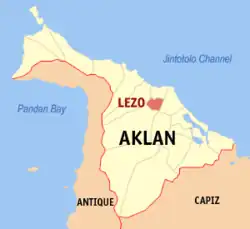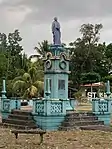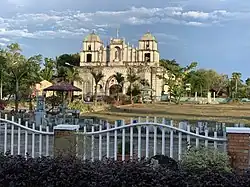Lezo
Tierra Alta | |
|---|---|
| Municipality of Lezo | |
 Church of Lezo | |
 Seal | |
 Map of Aklan with Lezo highlighted | |
OpenStreetMap | |
.svg.png.webp) Lezo Location within the Philippines | |
| Coordinates: 11°40′11″N 122°19′37″E / 11.6697°N 122.3269°E | |
| Country | Philippines |
| Region | Western Visayas |
| Province | Aklan |
| District | 2nd district |
| Barangays | 12 (see Barangays) |
| Government | |
| • Type | Sangguniang Bayan |
| • Mayor | Mary Lenette R. Fernandez |
| • Vice Mayor | George R. Villarubia |
| • Representative | Teodorico T. Haresco Jr. |
| • Municipal Council | Members |
| • Electorate | 10,039 voters (2022) |
| Area | |
| • Total | 23.40 km2 (9.03 sq mi) |
| Elevation | 22 m (72 ft) |
| Highest elevation | 189 m (620 ft) |
| Lowest elevation | 2 m (7 ft) |
| Population (2020 census)[3] | |
| • Total | 15,639 |
| • Density | 670/km2 (1,700/sq mi) |
| • Households | 3,916 |
| Economy | |
| • Income class | 5th municipal income class |
| • Poverty incidence | 9.88 |
| • Revenue | ₱ 72.61 million (2020) |
| • Assets | ₱ 174.8 million (2020) |
| • Expenditure | ₱ 60.61 million (2020) |
| • Liabilities | ₱ 49.75 million (2020) |
| Service provider | |
| • Electricity | Aklan Electric Cooperative (AKELCO) |
| Time zone | UTC+8 (PST) |
| ZIP code | 5605 |
| PSGC | |
| IDD : area code | +63 (0)36 |
| Native languages | Aklanon Hiligaynon Tagalog |
Lezo, officially the Municipality of Lezo (Aklanon: Banwa it Lezo; Hiligaynon: Banwa sang Lezo; Tagalog: Bayan ng Lezo), is a 5th class municipality in the province of Aklan, Philippines. It is the smallest municipality in the province both by population and by land area, and even by revenue. According to the 2020 census, it has a population of 15,639 people.[3]
History
.png.webp)
Before its creation into an independent municipality, Lezo was a barrio in Kalibo called Guicod derived from the word "Guicab" which means "a cavern in a creek where eels were in abundance", and was also known as Tierra Alta meaning a "high land" because the town center was not inundated during the great flood of the early 19th century.[5]
When the Americans came in 1899, the military government appointed Felix Kimpo as head of the Calivo (covering the present territory of Kalibo, Numancia and Lezo). During the election in 1901 he was elected as the president from 1901 to 1903. At that time there were 34 towns in the province of Capiz, but these were reduced to 24 towns by a law passed by the civil Commission when it was found out that some towns were incapable of meeting their financial obligations and maintenance. So on April 4, 1903, through Act No. 720 of the Philippine Commission, Lezo, along with Numancia, and Banga was annexed to Kalibo for decreased of revenue collections.
On July 31, 1909, the civil commission issued Executive Order No. 58[6] separating Lezo (that includes Numancia) from Kalibo and making Lezo as the seat of government. Numancia then, became a barrio of Lezo. On December 31, 1916, through Act No. 2657, Lezo was part of the second district of the province of Capiz. On March 10, 1917, through Act No. 2711 Lezo was part of the third district of Capiz. In 1920 the situation was reversed with regards to the status of Lezo and Numancia. By Executive Order No. 17, series of 1920, the seat of government was transferred to Numancia and Lezo became a barrio of Numancia.
With several petitions by the residents over the years to separate from Numancia, President Manuel Quezon signed Executive Order No. 364 dated August 28, 1941 converting Lezo into an independent municipality.[7] The inauguration of Lezo as a separate municipality was scheduled in 1942, but due to the outbreak of World War II it was deferred to January 1, 1945.
Geography
Lezo is located at 11°40′11″N 122°19′37″E / 11.6697°N 122.3269°E. It is 11 kilometres (6.8 mi) from the provincial capital Kalibo.

According to the Philippine Statistics Authority, the municipality has a land area of 23.40 square kilometres (9.03 sq mi) [8] constituting 1.28% of the 1,821.42-square-kilometre- (703.25 sq mi) total area of Aklan.
Climate
| Climate data for Lezo, Aklan | |||||||||||||
|---|---|---|---|---|---|---|---|---|---|---|---|---|---|
| Month | Jan | Feb | Mar | Apr | May | Jun | Jul | Aug | Sep | Oct | Nov | Dec | Year |
| Mean daily maximum °C (°F) | 28 (82) |
29 (84) |
30 (86) |
32 (90) |
32 (90) |
30 (86) |
29 (84) |
29 (84) |
29 (84) |
29 (84) |
29 (84) |
28 (82) |
30 (85) |
| Mean daily minimum °C (°F) | 23 (73) |
22 (72) |
23 (73) |
23 (73) |
25 (77) |
25 (77) |
25 (77) |
24 (75) |
24 (75) |
24 (75) |
24 (75) |
23 (73) |
24 (75) |
| Average precipitation mm (inches) | 47 (1.9) |
33 (1.3) |
39 (1.5) |
48 (1.9) |
98 (3.9) |
150 (5.9) |
169 (6.7) |
147 (5.8) |
163 (6.4) |
172 (6.8) |
118 (4.6) |
80 (3.1) |
1,264 (49.8) |
| Average rainy days | 11.4 | 8.2 | 9.3 | 9.7 | 19.1 | 25.6 | 27.4 | 25.5 | 25.5 | 25.2 | 18.5 | 14.5 | 219.9 |
| Source: Meteoblue[9] | |||||||||||||
Barangays
Lezo is politically subdivided into 12 barangays.[10] Each barangay consists of puroks and some have sitios.
| PSGC | Barangay | Population | ±% p.a. | |||
|---|---|---|---|---|---|---|
| 2020[3] | 2010[11] | |||||
| 060408001 | Agcawilan | 10.0% | 1,565 | 1,351 | 1.48% | |
| 060408002 | Bagto | 6.4% | 997 | 1,027 | −0.30% | |
| 060408003 | Bugasongan | 7.9% | 1,231 | 1,183 | 0.40% | |
| 060408004 | Carugdog | 9.1% | 1,428 | 1,369 | 0.42% | |
| 060408005 | Cogon | 6.2% | 970 | 893 | 0.83% | |
| 060408006 | Ibao | 9.0% | 1,413 | 1,317 | 0.71% | |
| 060408007 | Mina | 7.4% | 1,158 | 1,052 | 0.96% | |
| 060408008 | Poblacion | 12.6% | 1,975 | 2,113 | −0.67% | |
| 060408009 | Santa Cruz | 7.9% | 1,238 | 1,132 | 0.90% | |
| 060408010 | Santa Cruz Bigaa | 6.9% | 1,086 | 1,038 | 0.45% | |
| 060408011 | Silakat-Nonok | 5.9% | 919 | 856 | 0.71% | |
| 060408012 | Tayhawan | 8.0% | 1,244 | 1,187 | 0.47% | |
| Total | 15,639 | 14,518 | 0.75% | |||
Demographics
| Year | Pop. | ±% p.a. |
|---|---|---|
| 1903 | 3,612 | — |
| 1918 | 11,503 | +8.03% |
| 1948 | 6,008 | −2.14% |
| 1960 | 5,942 | −0.09% |
| 1970 | 6,890 | +1.49% |
| 1975 | 8,224 | +3.61% |
| 1980 | 9,625 | +3.19% |
| 1990 | 10,343 | +0.72% |
| 1995 | 11,536 | +2.07% |
| 2000 | 12,393 | +1.55% |
| 2007 | 13,077 | +0.74% |
| 2010 | 14,518 | +3.88% |
| 2015 | 15,224 | +0.91% |
| 2020 | 15,639 | +0.53% |
| Source: Philippine Statistics Authority[12][11][13][14] | ||
In the 2020 census, Lezo had a population of 15,639.[3] The population density was 670 inhabitants per square kilometre (1,700/sq mi).
Economy
Image gallery
 Town plaza in front of the Church
Town plaza in front of the Church Church in Lezo
Church in Lezo
References
- ↑ Municipality of Lezo | (DILG)
- ↑ "2015 Census of Population, Report No. 3 – Population, Land Area, and Population Density" (PDF). Philippine Statistics Authority. Quezon City, Philippines. August 2016. ISSN 0117-1453. Archived (PDF) from the original on May 25, 2021. Retrieved July 16, 2021.
- 1 2 3 4 Census of Population (2020). "Region VI (Western Visayas)". Total Population by Province, City, Municipality and Barangay. Philippine Statistics Authority. Retrieved 8 July 2021.
- ↑ "PSA Releases the 2018 Municipal and City Level Poverty Estimates". Philippine Statistics Authority. 15 December 2021. Retrieved 22 January 2022.
- ↑ "History". Municipality of Lezo. Archived from the original on 6 January 2015. Retrieved 21 October 2016.
- ↑ https://quod.lib.umich.edu/p/philamer/atf7298.0007.001/150?page=root;rgn=full+text;size=100;view=image;q1=lezo
- ↑ "Executive Order No. 364; Segregating from the Municipality of Numancia, Province of Capiz, the Barrio of Lezo and Organizing the Same Into a Separate Municipality Under the Name of Lezo, with the Seat of Government at the Barrio of Lezo". Official Gazette of the Republic of the Philippines. Malacañan Palace, Manila, Philippines. 28 August 1941. Retrieved 21 October 2016.
- ↑ "Province: Aklan". PSGC Interactive. Quezon City, Philippines: Philippine Statistics Authority. Retrieved 12 November 2016.
- ↑ "Lezo: Average Temperatures and Rainfall". Meteoblue. Retrieved 1 May 2020.
- ↑ "Municipal: Lezo, Aklan". PSGC Interactive. Quezon City, Philippines: Philippine Statistics Authority. Retrieved 8 January 2016.
- 1 2 Census of Population and Housing (2010). "Region VI (Western Visayas)" (PDF). Total Population by Province, City, Municipality and Barangay. National Statistics Office. Retrieved 29 June 2016.
- ↑ Census of Population (2015). "Region VI (Western Visayas)". Total Population by Province, City, Municipality and Barangay. Philippine Statistics Authority. Retrieved 20 June 2016.
- ↑ Censuses of Population (1903–2007). "Region VI (Western Visayas)". Table 1. Population Enumerated in Various Censuses by Province/Highly Urbanized City: 1903 to 2007. National Statistics Office.
{{cite encyclopedia}}: CS1 maint: numeric names: authors list (link) - ↑ "Province of Aklan". Municipality Population Data. Local Water Utilities Administration Research Division. Retrieved 17 December 2016.
- ↑ "Poverty incidence (PI):". Philippine Statistics Authority. Retrieved December 28, 2020.
- ↑ "Estimation of Local Poverty in the Philippines" (PDF). Philippine Statistics Authority. 29 November 2005.
- ↑ "2003 City and Municipal Level Poverty Estimates" (PDF). Philippine Statistics Authority. 23 March 2009.
- ↑ "City and Municipal Level Poverty Estimates; 2006 and 2009" (PDF). Philippine Statistics Authority. 3 August 2012.
- ↑ "2012 Municipal and City Level Poverty Estimates" (PDF). Philippine Statistics Authority. 31 May 2016.
- ↑ "Municipal and City Level Small Area Poverty Estimates; 2009, 2012 and 2015". Philippine Statistics Authority. 10 July 2019.
- ↑ "PSA Releases the 2018 Municipal and City Level Poverty Estimates". Philippine Statistics Authority. 15 December 2021. Retrieved 22 January 2022.